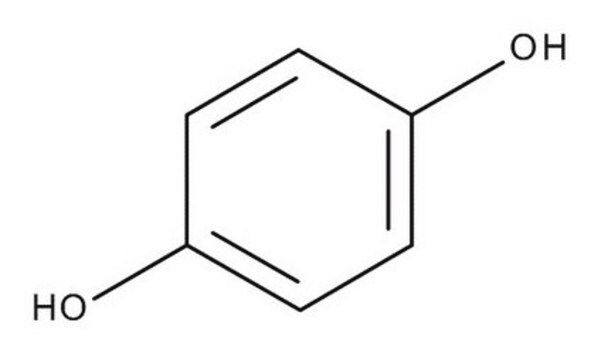Wichtige Dokumente
1324002
USP
Hydrochinon
United States Pharmacopeia (USP) Reference Standard
Synonym(e):
1,4-Dihydroxy-benzol, p-Dioxybenzol
About This Item
Empfohlene Produkte
Qualität
pharmaceutical primary standard
Dampfdichte
3.81 (vs air)
Dampfdruck
1 mmHg ( 132 °C)
API-Familie
hydroquinone
Selbstzündungstemp.
930 °F
Hersteller/Markenname
USP
bp
285 °C (lit.)
mp (Schmelzpunkt)
172-175 °C (lit.)
Anwendung(en)
pharmaceutical (small molecule)
Format
neat
SMILES String
Oc1ccc(O)cc1
InChI
1S/C6H6O2/c7-5-1-2-6(8)4-3-5/h1-4,7-8H
InChIKey
QIGBRXMKCJKVMJ-UHFFFAOYSA-N
Suchen Sie nach ähnlichen Produkten? Aufrufen Leitfaden zum Produktvergleich
Allgemeine Beschreibung
Anwendung
Also, for use with USP monographs such as:
- Hydroquinone Cream
- Hydroquinone Topical Solution
Hinweis zur Analyse
Sonstige Hinweise
Ähnliches Produkt
Signalwort
Danger
Gefahreneinstufungen
Acute Tox. 4 Oral - Aquatic Acute 1 - Aquatic Chronic 1 - Carc. 2 - Eye Dam. 1 - Muta. 2 - Skin Sens. 1B
Lagerklassenschlüssel
11 - Combustible Solids
WGK
WGK 3
Flammpunkt (°F)
329.0 °F - closed cup
Flammpunkt (°C)
165 °C - closed cup
Hier finden Sie alle aktuellen Versionen:
Analysenzertifikate (COA)
Leider sind derzeit keine COAs für dieses Produkt online verfügbar.
Wenn Sie Hilfe benötigen, wenden Sie sich bitte an Kundensupport
Besitzen Sie dieses Produkt bereits?
In der Dokumentenbibliothek finden Sie die Dokumentation zu den Produkten, die Sie kürzlich erworben haben.
Kunden haben sich ebenfalls angesehen
Unser Team von Wissenschaftlern verfügt über Erfahrung in allen Forschungsbereichen einschließlich Life Science, Materialwissenschaften, chemischer Synthese, Chromatographie, Analytik und vielen mehr..
Setzen Sie sich mit dem technischen Dienst in Verbindung.








